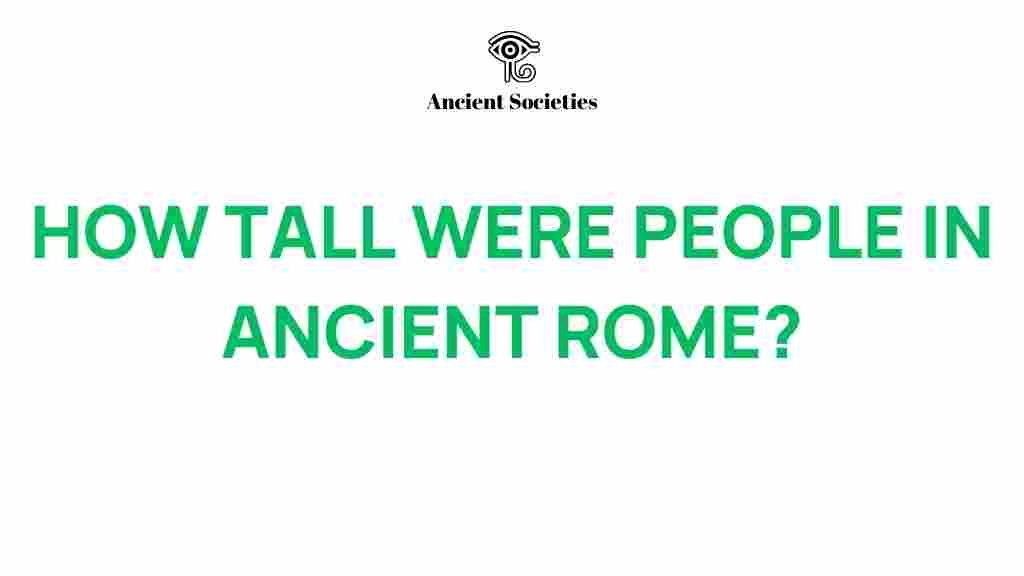Unveiling the Heights: The Stature of Ancient Romans Explored
The study of Ancient Rome offers fascinating insights into the culture, society, and daily lives of its people. One intriguing aspect of this exploration is the height of the ancient Romans, which serves as a reflection of their health, nutrition, and overall living conditions. In this article, we will delve into the archaeological findings, historical context, and anthropological insights that reveal the average stature of the Roman population.
The Historical Context of Roman Heights
Understanding the average height of individuals in Ancient Rome requires examining the social and economic conditions of the time. The Roman Empire spanned a vast geographic area, encompassing diverse cultures and societies. This diversity influenced everything from diet to lifestyle, ultimately impacting the physical stature of its inhabitants.
Measurements and Archaeological Findings
Recent archaeological discoveries have provided a wealth of information about the physical characteristics of ancient Romans. Here are some key findings:
- Male Height: Studies suggest that the average height of male Romans during the Imperial period (27 BC – 476 AD) ranged between 5’5″ to 5’7″ (165 cm to 170 cm).
- Female Height: Females were generally shorter, with an average height of around 5’2″ to 5’4″ (157 cm to 162 cm).
- Geographical Variations: Height varied significantly across different regions of the Empire, influenced by local diets and health conditions.
These measurements were derived from skeletal remains found in various archaeological sites, which provide a direct window into the physical attributes of the Roman populace.
Factors Influencing Height in Ancient Rome
Several factors contributed to the stature of ancient Romans:
- Nutrition: The diet of ancient Romans was varied and included grains, vegetables, fruits, and meats. Access to quality nutrition was crucial for growth.
- Health and Medicine: The prevalence of diseases and the availability of medical care impacted overall health, which in turn affected height.
- Social Status: Wealthier individuals often had better access to nutrition and health care, resulting in taller stature compared to the lower classes.
Anthropological Insights
Anthropology provides a broader context for understanding the stature of the Roman population. The field examines how genetics, environment, and culture intersect to influence physical characteristics.
In the case of Ancient Rome, anthropologists have noted:
- Genetic Diversity: The Roman Empire’s extensive reach meant a mix of genetic backgrounds, contributing to variations in height.
- Cultural Practices: Different regions had unique cultural practices that influenced diet and health, affecting physical stature.
Societal Reflections on Stature
The height of individuals in Ancient Rome was not just a physical characteristic but also a reflection of societal values and perceptions. Taller individuals were often viewed as more attractive and capable, influencing social dynamics.
Roman literature and art frequently depict idealized images of the human form. These representations reflect societal aspirations regarding stature:
- Physical Ideal: Tall figures were often associated with strength and power, especially in military contexts.
- Mythology: Roman myths often celebrated heroes and gods who embodied physical perfection, influencing societal standards.
Step-by-Step Process: Measuring Height in Archaeology
To understand how archaeologists determine the height of ancient populations, consider the following step-by-step process:
- Excavation: Archaeologists excavate burial sites and retrieve skeletal remains.
- Preservation: The bones are carefully cleaned and preserved for study.
- Analysis: Researchers analyze the skeletal remains using various methods, including osteometric techniques.
- Estimation: Height is estimated based on the length of specific bones, primarily the femur and tibia.
- Data Comparison: Findings are compared with other archaeological discoveries to establish average heights.
Troubleshooting Tips for Height Studies
When studying the height of ancient populations, researchers may encounter several challenges:
- Preservation Issues: Bones may not be well-preserved, complicating accurate measurements.
- Sampling Bias: The sample size may not represent the entire population if certain groups are underrepresented in archaeological findings.
- Historical Context: Researchers must consider the historical context, as changes in diet and health over time can skew results.
Addressing these issues requires careful methodological approaches and a multidisciplinary perspective, incorporating insights from archaeology, anthropology, and history.
Height and Modern Implications
Understanding the heights of ancient Romans can offer valuable insights into contemporary issues. For instance, examining the impact of nutrition and health on growth can inform current public health policies.
Moreover, the study of human stature across different cultures and time periods highlights the importance of environmental factors in shaping our physical characteristics. As modern society grapples with issues of nutrition and health, the lessons from Ancient Rome remain relevant.
Conclusion
Exploring the stature of ancient Romans not only enriches our understanding of Ancient Rome but also serves as a lens through which we can view broader societal trends. From archaeological discoveries to anthropological analyses, the insights gained illuminate the complex interplay between height, health, and societal values in one of history’s most influential civilizations.
For those interested in diving deeper into the topic, you can explore more articles on archaeological findings and their implications on modern society. Additionally, for a broader understanding of human anthropology, refer to this external resource.
This article is in the category Archaeology and created by AncientSocieties Team

1 thought on “Unveiling the Heights: The Stature of Ancient Romans Explored”